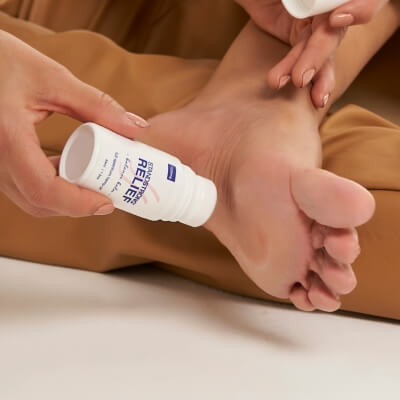Dr. Stilwell Recommendations
Treat Bunions Before Surgery!
Bunions, also known as Hallux Valgus, are bony bumps on the joint at the base of the big toe, causing foot pain and discomfort. They affect a significant portion of the population and can worsen over time if left untreated.
Causes of Bunions: Bunions develop due to a combination of genetic and environmental factors. The primary causes include:
- Genetic Predisposition: A family history of bunions increases the risk, indicating a genetic tendency towards the condition.
- Improper Footwear: Wearing tight, narrow, or high-heeled shoes can exacerbate bunions by putting excessive pressure on the toes.
- Biomechanical Issues: Conditions like low arches, flat feet, and overpronation can lead to instability around the metatarsophalangeal (MTP) joint, contributing to bunion formation.
- Prolonged Standing or Walking: Occupations requiring long standing or walking periods can increase the risk of bunions.
PODIATRY ADVICE
5 steps for Preventing and Healing Bunions.
Using bunion correction spacers and bunion pads can protect the sore bunion joint from shoe pressure and friction and provide significant bunion pain relief. We highly recommend wearing daily the PediFix® Visco-GEL® Dual-Action Bunion Fix™. It has the perfect combination of bunion correction and protection. All good pads for feet, especially pads for women, are made of a special gel that releases mineral oil to soothe and soften the skin, offering comfort and protection.
1. Good Shoes are the key!
One of the most effective ways to prevent and relieve bunion pain is by wearing appropriate footwear. Shoes with a wide toe box and good arch support can help reduce pressure on the bunion and prevent it from worsening. Brands such as Orthofeet or Hoka, offer shoes designed to accommodate bunions and promote foot health.
Having shoes in your closet that promote foot health doesn't have to be boring!
2. Relieve bunion pain with Gel Spacers and Pads for women
Using bunion correction spacers and bunion pads can protect the sore bunion joint from shoe pressure and friction and provide significant bunion pain relief.
We highly recommend wearing daily the PediFix® Visco-GEL® Dual-Action Bunion Fix™. It has the perfect combination of bunion correction and protection. These pads for women, are made of a special gel that releases mineral oil to soothe and soften the skin.
If you have little toe bunions and with irritation, this product is perfect to be worn daily, the PediFix® Visco-GEL® Little Toe Bunion Guard, crafted to safeguard this delicate area. Its advanced Gel formula not only provides soothing relief but also softens the skin for enhanced comfort.
3. Wear splints for bunions every night
Bunion splints are useful in managing bunion pain by preventing the big toe from rubbing against the second toe and helping to realign the joint.
You can wear our best recommendation to promote proper big toe alignment or bunion correction, the PediFix® Nighttime Bunion Regulator™. This device can be worn every night and you will feel a big relief while correcting bunions
4. Wear daily Stand Strong® Arch Supports!
Our wonderful Stand Strong Alignment Technology - SSAT™ was designed to help encourage better toe and foot alignment, promoting overall comfort and balance. With its innovative design, Stand Strong® arches gently support your feet, potentially enhancing your stride and providing a more comfortable walking experience.
While wearing these comfortable foot pads and gradually breaking them in, you'll enjoy added comfort and support for your feet. The best part is, they can be worn with any type of shoe—even sandals!
5. Exercises and Stretches as bunion self care
Regular exercises and stretches can strengthen the muscles around the affected joint and improve foot mobility. Toe stretches, like band exercises and toe curls, enhance toe strength and flexibility. Yoga poses such as downward dog and seated forward bend can also stretch and strengthen the muscles around the bunion, providing relief from discomfort.
bunion's surgery
Fixing Bunions Effectively with Minimally Invasive Bunion Surgery
When having an advanced large bunion and when conservative treatments fail to provide adequate relief, surgical options may be considered. Minimally invasive bunion surgery offers several advantages over traditional procedures:
- Reduced Recovery Time
- Minimal Scarring
- Immediate Weight-Bearing
- Improved Stabilization
There are numerous ways to address bunions, from wearing proper footwear and using bunion pads to incorporating exercises and considering minimally invasive surgery. Contact your podiatrist for more information.
Medical Disclaimer
Our product is not intended to diagnose, treat, cure, or prevent any disease. The Stand Strong® Arch is designed to minimize stress on the foot thereby maximizing stability and comfort. We make no claims or guarantees of payment or reimbursement by insurance companies.
Medical Disclaimer
Our product is not intended to diagnose, treat, cure, or prevent any disease. The Stand Strong® Arch is designed to minimize stress on the foot thereby maximizing stability and comfort. We make no claims or guarantees of payment or reimbursement by insurance companies.
Diabetics and Those with Neuropathy
Please contact your physician or other qualified healthcare practitioner before using this product. If you have decreased sensation or other skin/nerve damage, please consult with your healthcare practitioner before adhering this elastomer material to your foot.
Medical Disclaimer
Our product is not intended to diagnose, treat, cure, or prevent any disease. The Stand Strong® Arch is designed to minimize stress on the foot thereby maximizing stability and comfort. We make no claims or guarantees of payment or reimbursement by insurance companies.
Diabetics and Those with Neuropathy
Please contact your physician or other qualified healthcare practitioner before using this product. If you have decreased sensation or other skin/nerve damage, please consult with your healthcare practitioner before adhering this elastomer material to your foot.









